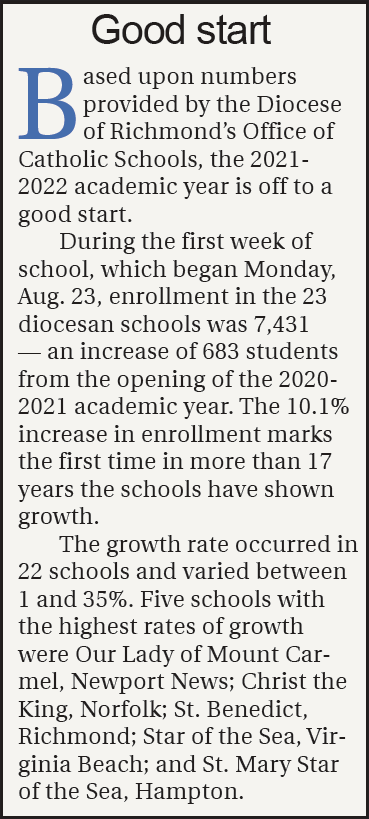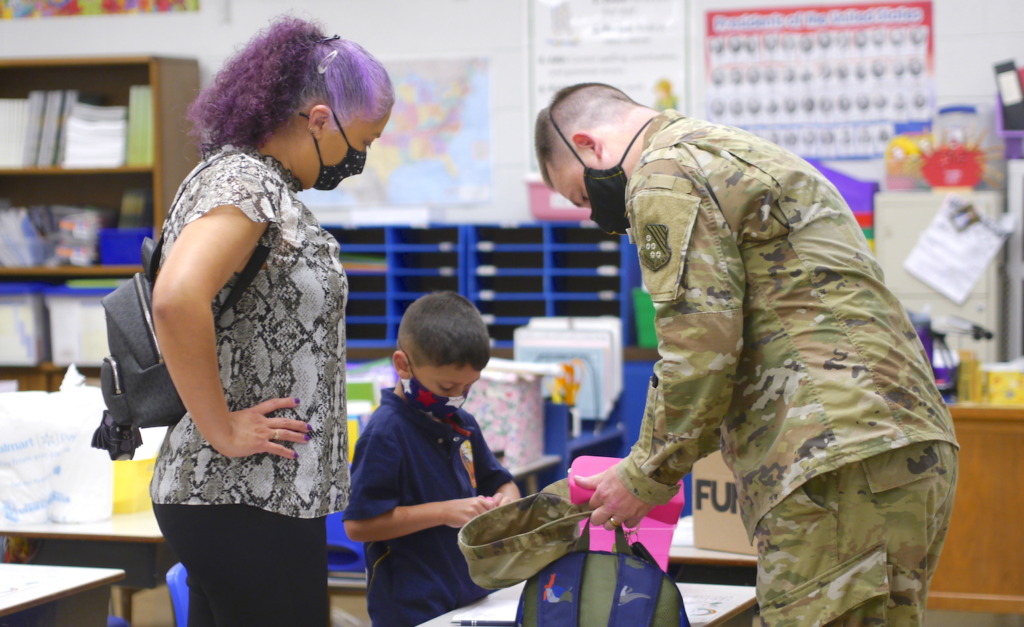Presenters offer teachers strategies at professional day
It’s a life full of hellos and goodbyes for children in military families. They attend an average of six to nine schools before graduating, and they deal with parent deployments to locations afar.
That was a message that Julie Coffey and Kim Shoffner, trainers with the non-profit Military Child Education Coalition (MCEC), shared during their Aug. 18 presentation at a virtual professional day for Catholic educators in the diocese. They spoke on how to recognize and respond to the needs of military-connected students.
The Diocese of Richmond’s Office of Catholic Schools sponsored the day, whose theme was “Teach as Jesus Did: Meeting the Needs of Catholic School Students.” Approximately 750 educators participated.
 Shoffner defined military-connected students as children and youth who have at least one parent or guardian who is on active duty in the armed forces or who is a veteran, member of the Reserves or in the National Guard.
Shoffner defined military-connected students as children and youth who have at least one parent or guardian who is on active duty in the armed forces or who is a veteran, member of the Reserves or in the National Guard.
Coffey said some of the top challenges facing military-connected children and youth are parent deployment, frequent relocation, adapting to new schools, making friends and tension at home.
But there is a bright side.
Those experiences provide military-connected students “the opportunity to develop some pretty amazing strengths,” Shoffner said, noting that they are resilient and are often optimistic, tolerant, resourceful, adaptable and responsible. They tend to welcome challenges, have good peer relationships and a greater respect for authority. They can be empathic and are likely to befriend someone who is “different” because they know what it’s like to be “an outsider” and feel like they “don’t fit into the group.”
When teachers at the event were asked how relocating can affect military-connected students, some of the challenges they typed online were loneliness, making friends, stress and the feeling of lack of control.
Therefore, providing a consistent and structured environment Needs of military-connected students addressed is crucial, Shoffner said. Coffey added that it gives “some solace” to military-connected students to be able to predict what will happen, especially if family life is unpredictable at that time. It could be soothing for a child to know when the bell will ring, where their cubby is, that lunch follows a particular subject and that they go to Mass once a week.
“Schools can really be that stable foundation for those families,” Shoffner said. “Kids crave routine. It’s something they can really depend on.”
Building positive relationships with students and their families is “key,” Shoffner said, adding that it opens doors to communication, lets students know that the teacher cares about them and allows teachers to identify and respond to students’ needs.
Young students might not have the vocabulary to express themselves when a parent is deployed, Shoffner said. It might benefit elementary school children to engage in play activities such as using puppets or role playing.
Teachers may use storytelling that depicts a child in conflict and then discuss as a class how the character solved the conflict and if the decision was “good or bad.” Some students might want to journal, write or dictate a letter to the deployed parent, paint or draw pictures reflecting their feelings or make a memory book.
Shoffner said some strategies a teacher might use to help middle and high school students deal with separation are assigning students to write poetry or stories about their experiences or express themselves through art. Some students find it helpful to listen to music, exercise, and practice breathing and muscle relaxation exercises.
When necessary, professional counseling is valuable for students of all grades, Shoffner said.
When teachers were asked for strategies or tips to address the “unique challenges” of military- connected students, some of their answers typed online were icebreakers, buddy systems, community building, journaling, and being open and compassionate.
Many teachers said the convocation reinforced concepts they already knew and validated that they are on the right track in regards to teaching military-connected students. Some teachers said they learned information that has stirred them to employ more strategies.
For example, starting this year, kindergarten teacher Shirley McCartney at St. Pius X School, Norfolk, will meet with deploying parents before they leave to discuss how to communicate with them while they are gone. She plans to offer to send artwork, letters, photos of the children and other materials to the deployed parent. She also plans to offer “courtesy conferences” with both parents when the military parent returns to give an opportunity to see the classroom, ask questions and “get up to speed” on what the child is doing.
For Mark Zafra, St. Pius X School principal, “a big take away” from the convocation was learning about the MCEC website, SchoolQuest, and other resources for teachers, military-connected students and their families.
Similarly, Douglas Ziegenfuss, history teacher at Catholic High School, Virginia Beach, said learning about resources adds another “tool” in his “toolbox” to help military-connected students “succeed in my classroom.”
In addition to the presentation on military-connected students, Father Michael Renninger, pastor of St. Mary, Richmond, and Immaculate Heart of Mary Sister Patricia McCormack made separate presentations on how teachers and staff can evangelize in school and the importance of doing so. Sister Patricia is the director of the IHM Office of Formative Support for Parents and Teachers, a ministry of the Immaculate Heart of Mary Congregation in Philadelphia.

